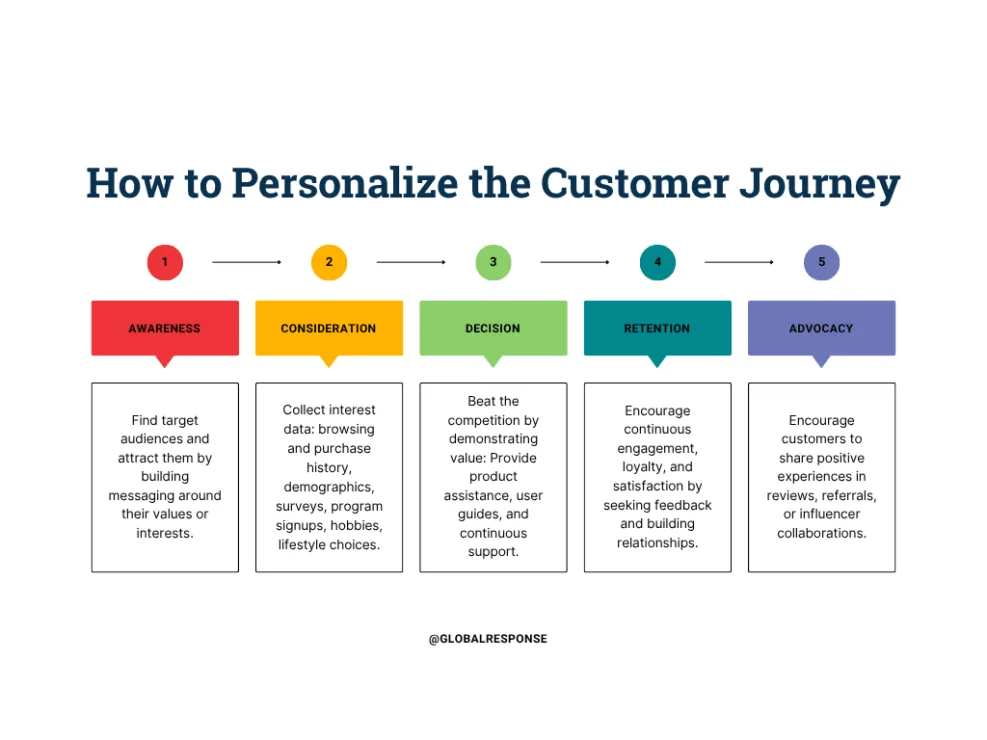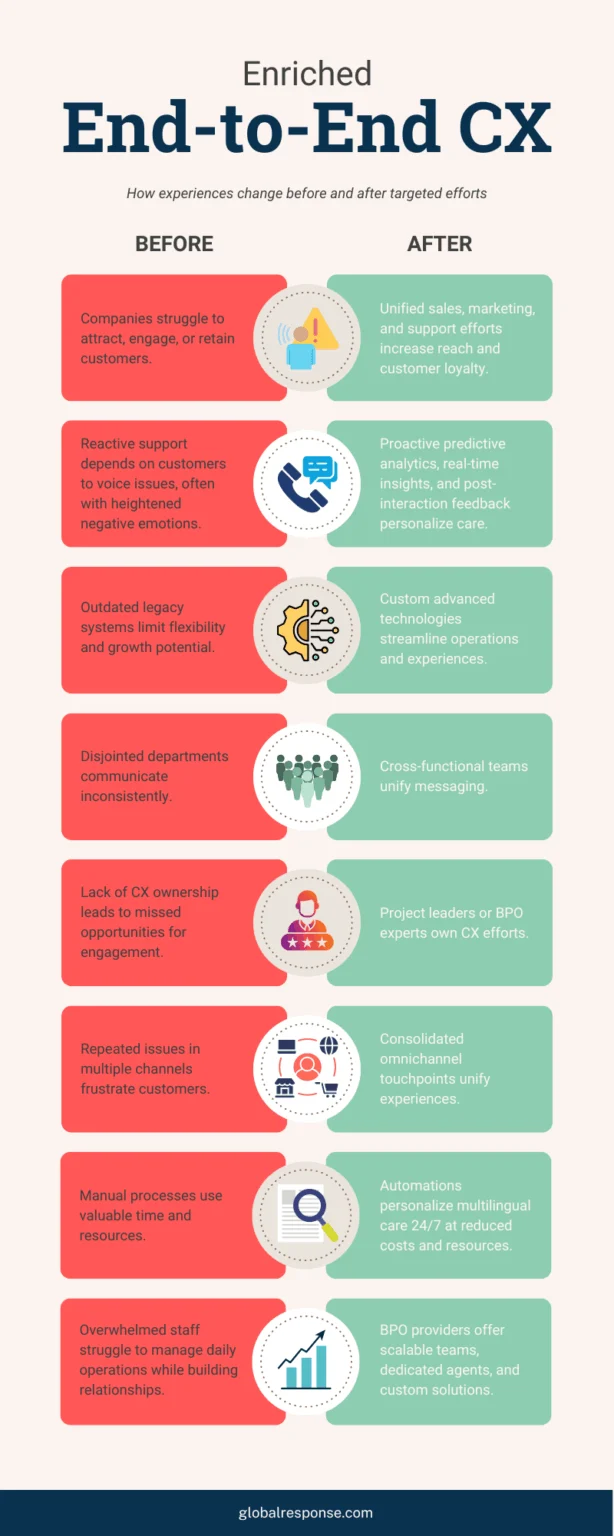Read Time: 12 minutes
Table of Contents
Introduction
Creating a customer experience that stands out means cultivating a unique, seamless, customized journey that customers want to keep enjoying. In a world with endless stimulation and diverse shopping experiences, a great customer journey should have these features:
- Efficient yet well paced
- Comprehensive yet personal
- Predictive yet responsive
The digital nature of interactions between customer and company raises expectations even higher. Customers expect 24/7 availability and solutions before they even realize they have a problem. Multiple communication channels increase not only opportunities for connection but also the risk of fragmented touchpoints, or inconsistent, disjointed experiences in multiple interactions with a brand.
Higher standards and risks bring a growing need for seamless, fully enriched end-to-end customer experiences. Learn how to optimize your customer experiences throughout each step of the journey by following the tips in this guide.
Key takeaways
- A seamless end-to-end customer experience drives loyalty and growth by creating a personalized, consistent journey across touchpoints.
- Advanced technology and real-time data insights are critical strategies to achieving CX success.
- Overcoming common CX challenges requires unified teams and strategies and aligns businesses with real customer needs and preferences.

What is an end-to-end customer experience?
Understanding CX — how it operates and how it affects customer engagement — is vital to optimizing it. Let’s start with the definition of what is an end-to-end customer experience:
An end-to-end customer experience is the whole journey, from initial contact to post-purchase, between a customer and a company.
This includes all customer touchpoints, so consistent high-quality service in each step is vital to crafting a positive and unified end-to-end experience.
Why a seamless customer journey matters more than ever
Customers may be growing more disillusioned than ever when it comes to how they perceive their own experiences with brands. Forrester’s 2025 global Customer Experience Index reported a decline in CX quality with a quarter of North American brands underperforming in CX for two consecutive years.
Still, hope is not lost: 7% of European brands improved CX scores, proving that while downward trends of customer loyalty are concerning, “brands must focus on providing stronger customer experiences to reverse the trend. Even a minor improvement to a brand’s customer experience quality can reduce churn and increase share of wallet.”
Brand loyalty boosts customer retention and opportunities for revenue growth, so putting a focus on a high-quality customer journey is a worthy investment for companies of all industries.
Key components of a seamless end-to-end experience
As Forrester’s principal analyst says, even minor improvements can make a significant impact. Take concrete steps to ensuring a seamless end-to-end experience by prioritizing your customers with these key components.
Omnichannel integration
An end-to-end experience starts where the customers are at, so your team needs the technology innovations that unify experiences across all platforms. Optimize your customer care with fully virtual omnichannel customer experience to track, manage, and enhance interactions across these channels and more:
- Web chat
- Phone calls
- Text messaging
- Various social media platforms
- In-person interactions
Comprehensive CX doesn’t begin and end with online communications. Ensure synchronization between omnichannel interactions and in-store service by immersing remote agents in company culture, policies, and voice for a truly optimized end-to-end experience.
Personalization
One effective way to grab and hold a viewer’s attention throughout the customer journey is to make your product or service a custom solution to their needs and preferences. Achieve relevance across channels by adjusting communications and marketing efforts to specific user behaviors.
Try these strategies to personalize various customer journey touchpoints:

Real-time responsiveness
Customers expect instant support, and thankfully, you can offer that, regardless of your staffing capabilities. Automations can handle simple interactions, point users to appropriate teams, or offer real-time support via chatbots. Implement these key forms of self-service for live assistance:
- Knowledge bases
- FAQs
- Troubleshooting guides
- Product usage tips
- AI chatbots
- Apps and web portals
Of course, beware the pitfall of relying too much on automation or self-service. Customers still seek the human touch, and live agents can expertly handle complex issues while de-escalating situations and building relationships with customers.
READ MORE: High-Touch CXM with Remote Teams: How to Humanize Outsourced Customer Support
Connected data and insights
Every interaction gives you valuable data about customer behavior and preferences, which should inform your strategies as you turn data into actionable insights through custom analytics. You simply need the tools to do so! Advanced contact center technology tracks, analyzes, organizes, automates reports, and makes predictions based off of these data. Unify your customer profiles and CRM platform with these tech innovations by integrating with digital customer service tools and learning how AI is transforming contact center CX.
Want to scale your business?
Global Response has a long track record of success in outsourcing customer service and call center operations. See what our team can do for you!
Steps to build an end-to-end customer experience strategy
Now that you have the tools and best practices for building a seamless customer experience, you can take these steps to achieving that coveted frictionless end-to-end digital experience.
1. Map the customer journey
Put yourself in your customers’ shoes to consider what services you need to provide to encourage their engagement in your processes, products, and community. While you should customize your customer journey to your specific processes, cover these five key stages of the customer journey.
- Awareness: Crucial for building brand recognition and attracting customers, this is when customers become aware of the brand through social media, ads, or word of mouth.
- Consideration: Customers evaluate the brand and compare it with competitors. This requires companies to demonstrate value and differentiate themselves.
- Decision or Purchase: Customers make a purchase. Fulfillment is crucial for confirming the proper fit.
- Retention: Customers continue engaging with the brand, seeking support and offering feedback. This stage maintains and improves customer loyalty and satisfaction.
- Advocacy: Customers share experiences, promoting the brand in reviews or word of mouth.
Pro tip: Use a customer persona to gather the characteristics, needs, motivations, and behaviors of specific segments of your audience.
2. Break down internal silos
Breaking down your customer experience efforts into silos will help organize and optimize strategies, as well as making use of the experts who can expertly implement them. Each department plays a crucial role in achieving your business mission and enhancing customer service.
- Sales – from lead qualification to appointments set and deals made
- Marketing – ads, digital engagement, customer personas, competitive positioning efforts
- Support collaboration – IT teams, managers
Be sure to establish clear goals and communication strategies to unify messaging and create collective ownership. Transparency, cross-functional teams, cross-training, and highlighting each silo’s contribution to CX impact will foster success across the company and the customer experience.
3. Implement the right technology stack
Technology enables your business to interact with customers, streamline operations, understand and predict behaviors, and provide the tools customers need to have a frictionless experience.
Work with a contact center to customize technology integrations with your current tech stack. Possible options include the following:
- Customer Data Platforms (CDPs): A platform that allows businesses to pull in customer data from any channel to build a unified customer profile.
- Customer Relationship Management (CRM): A system for managing all interactions between your business and current or potential customers.
- Automation tools: Available for various contact center purposes, AI technologies automate processes and offer real-time guidance and post-interaction analytics for constant improvement.
Seamless integrations will improve user experience, and custom workflows and interfaces will help your teams efficiently manage each stage of the customer journey.
4. Focus on proactive service
Reactive customer service responds to customer behaviors, complaints, and messaging. Proactive service uses analytics and data-informed insights to anticipate challenges and provide targeted assistance to prevent escalations.
Predictive engagement analyzes interactions and preferences across digital platforms to predict outcomes and personalize solutions, with follow-up suggestions based on what works best historically for similar users.
Proactive customer service improves customer satisfaction across their experience by reducing errors and providing tangible solutions when customers need it. It also shows customers you’re dedicated to constant growth, establishing trust and loyalty.
Common challenges (and how to overcome them)
End-to-end CX enrichment efforts go a long way to achieving a seamless experience, but common challenges can distract from the goal or inefficiently make use of your efforts. Try these tips for overcoming these common challenges for a powerful and impactful strategy.
Siloed data
While enriching various departments is necessary for a unified experience, too much isolation inhibits a holistic view of the customer journey and leads to inefficiencies, inconsistencies, and missed opportunities.
Solution: Set joint key performance indicators to ensure alignment across the organization. Rotate employees throughout the teams so they understand how each department operates. Establish unified goals and regularly meet to discuss updates and progress.
Lack of CX ownership
While each team plays a key role in CX enrichment and fulfillment, there should also be a project leader or team that owns overall CX strategy. Without clearly established roles, teams may not know who to turn to for assistance or the development of new ideas, causing you to miss out on opportunities for significant growth.
Solution: Find a project leader or contract with a contact center BPO to own all CX efforts.
Inconsistent brand messaging
Many hands make light work, but spreading duties to your various teams inevitably leaves room for subjective interpretation and possible inconsistent communications. This is particularly felt in sales, marketing, and customer support efforts.
Solution: Create scripts and style guides supporting core values for teams to follow. Regularly train on brand voice and culture to reinforce ideas and tailor strategy-specific messaging.
Inflexible legacy systems
Habits can be hard to break, and some employees may struggle to depart from systems or processes that have worked in the past. Old technologies, however, will fail to capture the live data, analytics, and insights key to proactive end-to-end CX.
Solution: Partner with a CX leader to tailor technology solutions to your business according to your CX needs. Seamlessly integrate old systems with new ones to securely handle customer data and train both internal employees and new hires on processes and systems.
Real-world example: A seamless journey in action
Global Response helped LACOSTE establish an online customer experience that matched the elite in-store experience and increased online customer conversions.
The teams prioritized representing the superiority of the brand through white-glove customer service across multiple channels. Brand immersion, on-site visits, and dedicated brand specialists used technology innovations and transparent reporting to meet goals and adapt to various needs across the customer journey.
Together, they lowered the cost of business while leaving an impressive impact. The team increased service capacity and speed of answer and personalized customer experience to boost satisfaction and retention.

Future trends in customer journey design
As brands get better at customizing CX, strategies should — and will — adapt to improve reach and effectiveness. Emerging trends will continue to change the game, connecting businesses and audiences at more stages of the customer journey with more nuance, empathy, and automation. Keep an eye on these future customer journey trends to anticipate how you can leverage new insights and technologies for ever-improving customer experiences.
- Predictive personalization: Predictive analytics is already making waves in end-to-end customer experience, and personalized service is the natural next place to apply historical and real-time insights.
- AI-powered journey orchestration: Automate customer journey mapping based on real behaviors and processes to fine-tune what works and get rid of what doesn’t, with automated summaries, check-ins, and reports.
- Journey analytics platforms: Technologies abound for every piece of customer support. As customer journey enhancement grows in relevance and importance, you can expect to see new platforms specializing in analyzing and optimizing end-to-end experiences.
- Touchpoint consolidation: Simple is best. Streamlining customer interactions and touchpoints across platforms reduces costs while improving experiences, boosting loyalty and retention.
Whether you’re a customer experience expert or not, working with a contact center BPO can help you leverage these ideas to set your business apart and establish long-lasting relationships with customers.
Conclusion
Designing a truly end-to-end customer experience adds value to your business and, most importantly, your customers. Unified messaging, enriched processes, personalized support, and adaptive strategies will help you engage meaningfully with audiences and understand their needs and preferences better than ever before.
Take action now to map the customer journey, unify data, and upgrade your tech stack for a seamless, comprehensive experience customers will want to keep turning back to. Contact Global Response to see how we can help you enrich your customer experience journey mapping.
End-to-end CX FAQs
An end-to-end customer experience is the complete customer journey covering every interaction a customer has with a brand — from awareness to post-purchase support — in a consistent, connected way.
Businesses can create a seamless customer journey by integrating data, aligning teams, mapping customer journeys, and using technology to create a personalized and frictionless experience.
A seamless experience is important in customer service because it reduces churn, increases satisfaction, builds trust, and enhances loyalty.
Tools such as CRMs, customer data platforms (CDPs), marketing automation, journey mapping tools, and omnichannel engagement platforms improve end-to-end customer experience.
Common gaps in customer journey design include disconnected systems, unaligned messaging, lack of journey visibility, and reactive instead of proactive service.




